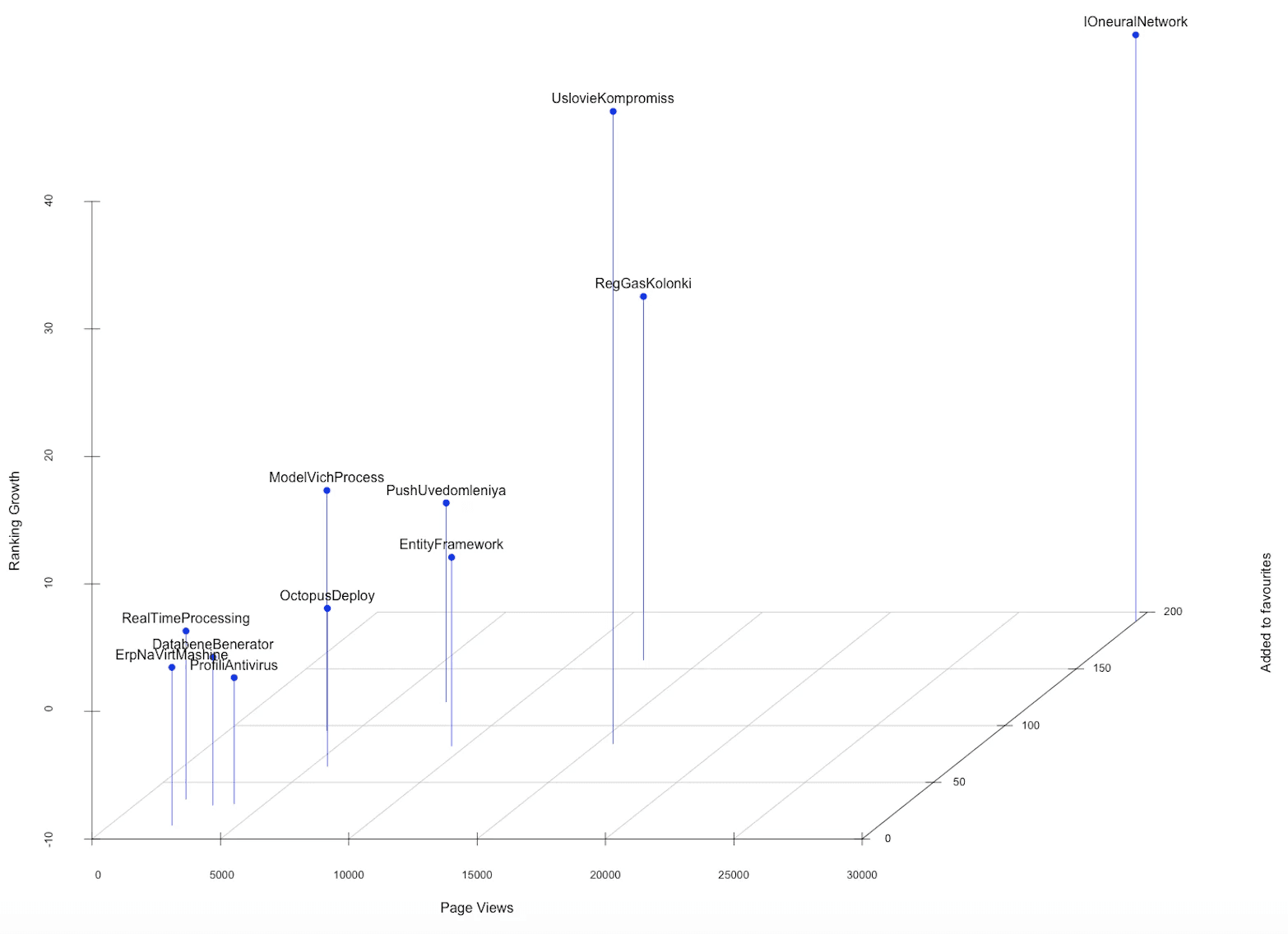48 hours of your publication on Habré
Someone with the help of Habr PR, someone leads their content strategy, and someone just shares interesting information. But everyone wants to know in advance what will happen to the published material, whether it will be popular or not, whether readers will like it. Is it possible to predict how many views the article will receive for the first three hours of its life?

To analyze and work on errors, we track our Habrovsk articles with the t.onthe.io service. Here is a comparison of our article (blue graph) with an article that appeared at about the same time and hung above us in an interesting (green graph):
')

An interesting fact: the ratio of add-ons to the number of views in the article is almost the same throughout the life of the article. Those. it can be concluded that the article is qualitatively evaluated equally all its lifetime - i.e. if you are loved in the first hours, then nothing should change in the future.
The ratio of additions to favorites on the second day is approximately 1.5%:

Once on Habré a study was published, on what day it is better to publish . We wondered if it was possible to predict how many views the article would have in 2 days after the first three hours of its life.
Dashboard
For the analysis, we selected the first 10 articles on Monday (07/13/2015) and one of our popular article about neural networks:
All articles were connected to the tracker at the same time. The variation in publication time: from 4 am to 13 pm, Moscow time. Metrics for research:
Comparison of the number of views of publications:

Data table:
According to the data, it is clear that the average increase in views of the majority of the articles studied is 243% . We excluded the anomalous values. Some articles have more than 400% increase in views, apparently due to the fact that they are in the best. In other articles, the increase is too small (80-100%), because they were published long before the tracker was turned on (the analysis began at 13:00 MSK).
As a result of the experiment, we can approximately know how many views the article will receive for the first three hours of its life. The increase is likely to be 240-250% .
A three-dimensional graph of the dependence of the growth of the author’s rating on the number of views and additions to favorites.

The more views and additions to favorites the article receives, the greater the rating gain of the author. This graphic does not take into account the likes of the publication; nevertheless, the connection is already visible. The authors of the articles, in which the number of views differs almost twice, got the same maximum rating increase.
According to the graphs you can see when the increase in views is on Habré. In the morning after 7:30, then in the afternoon after 13:00 and in the evening after 18:00. But it is also clear why this is happening. It's funny that on Friday after 18:00 the views drop, and on weekends they start to grow only after 10:00 Moscow time.
Our article about a smart crop with a fairly high conversion of views into asterisks (1%) did not become as popular as the article about Neural Networks (the final conversion was 0.5%).
When our article got into the weekly newsletter from Habr, the number of article views increased by only 6%.

By the way, this article is being tracked right now by our real-time service .
What other parameters of publications would be interesting to watch in real time?

To analyze and work on errors, we track our Habrovsk articles with the t.onthe.io service. Here is a comparison of our article (blue graph) with an article that appeared at about the same time and hung above us in an interesting (green graph):
')

An interesting fact: the ratio of add-ons to the number of views in the article is almost the same throughout the life of the article. Those. it can be concluded that the article is qualitatively evaluated equally all its lifetime - i.e. if you are loved in the first hours, then nothing should change in the future.
The ratio of additions to favorites on the second day is approximately 1.5%:

Once on Habré a study was published, on what day it is better to publish . We wondered if it was possible to predict how many views the article would have in 2 days after the first three hours of its life.
Why 48 hours
In the course of the experiment, we found out that after 48 hours, the number of views of the article slows down significantly.
The beginning of the experiment
Dashboard
For the analysis, we selected the first 10 articles on Monday (07/13/2015) and one of our popular article about neural networks:
| Publication | Short title |
| Basics of successful push notification implementation for mobile apps | pushUvedomleniya |
| Introduction to Octopus Deploy | octopusDeploy |
| Entity Framework 6 (7) vs NHibernate 4: a DDD perspective | entityFramework |
| ERP on a virtual machine: we are testing SAP + Oracle Database on virtual VMware and SCALA-R machines | erpNaVirtMashine |
| Automatic gas temperature controller | RegGasKolonki |
| Databene Benerator - Benefit from it. | DatabeneBenerator |
| Real-time data processing in AWS Cloud. Part 2 | RealTimeProcessing |
| Condition as a compromise | UslovieKompromiss |
| What do anti-virus protection profiles provide? | ProfiliAntivirus |
| Basics of successful push notification implementation for mobile apps | ModelVichProcess |
| How neural networks draw pictures | IOneuralNetwork |
All articles were connected to the tracker at the same time. The variation in publication time: from 4 am to 13 pm, Moscow time. Metrics for research:
- Comments
- Number of views.
- Add to favorites.
- Rating author.
Comparison of the number of views of publications:

Experimental results
Data table:
| Title | Count views after 3 h | Count views after 48 h | Growth percentage |
| pushUvedomleniya | 1240 | 7070 | 470% |
| erpNaVirtMashine | 656 | 2440 | 272% |
| octopusDeploy | 1950 | 5610 | 188% |
| entityFramework | 4650 | 9450 | 103% |
| RegGasKolonki | 3540 | 12,700 | 259% |
| DatabeneBenerator | 1610 | 3040 | 89% |
| RealTimeProcessing | 247 | 1710 | 592% |
| UslovieKompromiss | 4350 | 15630 | 259% |
| ProfiliAntivirus | 1160 | 3810 | 228% |
| ModelVichProcess | 1170 | 3810 | 226% |
| IOneuralNetwork | 8120 | 29990 | 269% |
According to the data, it is clear that the average increase in views of the majority of the articles studied is 243% . We excluded the anomalous values. Some articles have more than 400% increase in views, apparently due to the fact that they are in the best. In other articles, the increase is too small (80-100%), because they were published long before the tracker was turned on (the analysis began at 13:00 MSK).
As a result of the experiment, we can approximately know how many views the article will receive for the first three hours of its life. The increase is likely to be 240-250% .
A three-dimensional graph of the dependence of the growth of the author’s rating on the number of views and additions to favorites.

The more views and additions to favorites the article receives, the greater the rating gain of the author. This graphic does not take into account the likes of the publication; nevertheless, the connection is already visible. The authors of the articles, in which the number of views differs almost twice, got the same maximum rating increase.
More interesting observations
According to the graphs you can see when the increase in views is on Habré. In the morning after 7:30, then in the afternoon after 13:00 and in the evening after 18:00. But it is also clear why this is happening. It's funny that on Friday after 18:00 the views drop, and on weekends they start to grow only after 10:00 Moscow time.
Our article about a smart crop with a fairly high conversion of views into asterisks (1%) did not become as popular as the article about Neural Networks (the final conversion was 0.5%).
When our article got into the weekly newsletter from Habr, the number of article views increased by only 6%.

By the way, this article is being tracked right now by our real-time service .
What other parameters of publications would be interesting to watch in real time?
Abstract
- You can track articles on Habré using the t.onthe.io service.
- Conversion of views to favorites does not change over the life of the article.
- With some probability, it can be predicted that the article in 48 hours will receive 240-250% more views than in the first 3 hours of life.
- The increase in the number of views slows down after 48 hours of publication, unless of course it falls into the weekly newsletter.
Source: https://habr.com/ru/post/262617/
All Articles